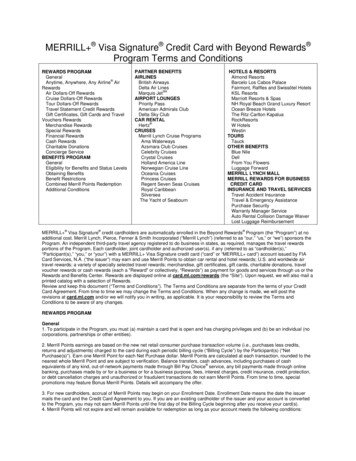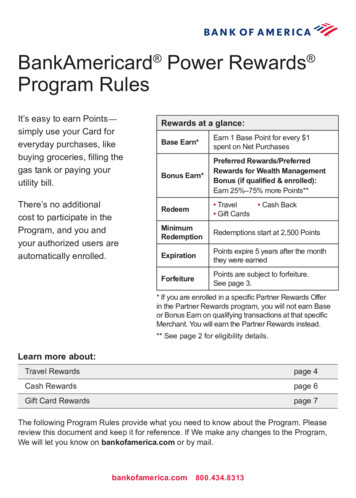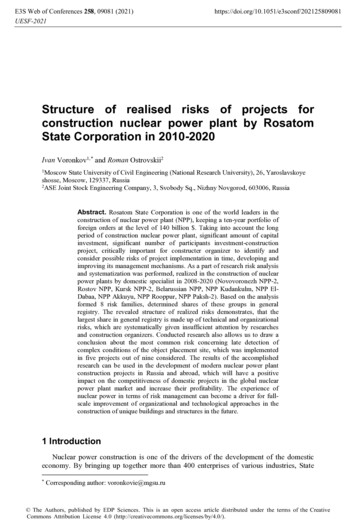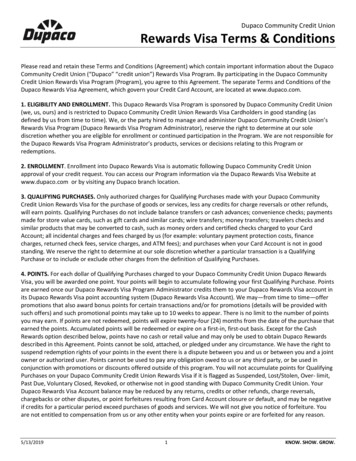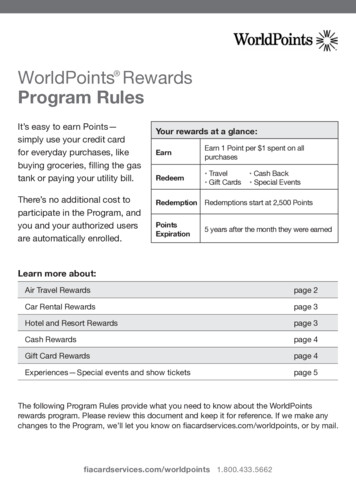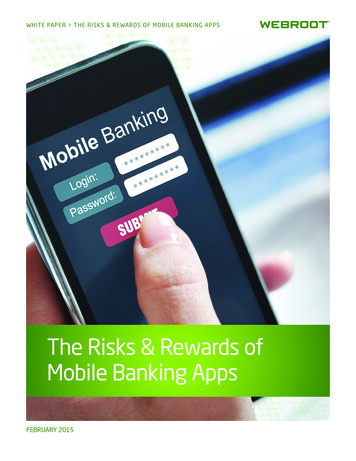
Transcription
WHITE PAPER THE RISKS & REWARDS OF MOBILE BANKING APPSThe Risks & Rewards ofMobile Banking AppsFEBRUARY 2015
WHITE PAPERTHE RISKS & REWARDS OF MOBILE BANKING APPSThe market demand for mobile banking technology and its rapidlyincreasing adoption rate means that many banks have been managingthe security risk of mobile apps almost entirely on their own. The rewardfor success is improved customer convenience and retention, andsubstantial operational cost savings.This paper looks at the risk/reward ratio as it exists today – as this isstill a highly dynamic and fast moving area – and how new securitytechnology from Webroot can help financial institutions become moreadept and efficient at managing their app risk/reward calculations.»» Higher risk of identity theft due to ease of account and documentaccess via email or cloud storage, etc.»» Unsafe data transmission over wireless connections, often unsecuredpublic Wi-Fi»» Unsafe data storage as mobile apps often save sensitive data, suchas banking PINs, card numbers, and passwords»» Sensitive data leakage due to poor app coding or authentication,exposing sensitive data to third partiesWHAT TYPES OF THREATS TARGET MOBILEBANKING USERS SPECIFICALLY?MOBILE APP USE INCREASESThe wildfire growth of mobile apps has added to financial institutionssecurity challenges. ABI Research estimates that over 56 billionsmartphone apps, plus another 14 billion tablet apps, weredownloaded worldwide in 20131.While the general security risk is getting much higher, particularly forAndroid device users, there are many mobile device attacks that presentsevere risks for financial institutions. Recent examples include:During 2014, the Webroot Mobile Threat Research team has seenan exponential increase in Android-based malware to over 3 millionmalicious or potential unwanted applications (PUAs). Meanwhile, thepercentage of apps that are trustworthy or benign has dropped from45 to 39 percent in the same timeframe.Trojans»» Zitmo – steals mTAN codes sent by banks in text messages»» Banker – steals passwords and other sensitive information»» Perkel/Hesperbot – uses JS injection on PC to request mobile number,delivers Trojan via SMS. Trojan poses as a security app.Such high volumes of app creation and downloads provide numerousopportunities for cybercriminals to find weak spots and infectcustomer devices»» Wrob – poses as the Google Play app and replaces installed bankingapps with Trojan clonesWHY ARE MOBILE DEVICES A GREATERSECURITY RISK THAN OTHER PLATFORMS?»» ZertSecurity – impersonates bank login, steals credentialsMobile devices present a far greater security risk when compared to alaptop or desktop for a variety of factors, such as:»» DroidDream – uses rageagainstthecage exploit to root the device, stealdata, install additional apps, execute remote commands»» Less user authentication, QR Codes, data sharing, SMS, NFC, etc.Spyware»» More focus on user convenience over user security»» Keyloggers – pose as third party keyboards that send keystroke andcontextual information»» Bankum – replaces legitimate versions of banking apps with fake ones»» Easier access to data on compromised mobile devices than computersRootkitsUsers of mobile apps worldwide by region 2012-2017201220132017App users worldwide1.2 billionN/A4.4 billionAsia Pacific30%32%47%Europe29%28%21%North America18%17%10%Middle East & Africa14%13%12%Latin America9%10%10%App Revenues 12 billion 20.4 billion 63.5 billionUsers set to grow to 4.4BN by 20171 The Wild, Wild West of Mobile Apps, TechTarget, 2013Source: Portio Research (March 2013) via: mobiThinking2
WHITE PAPEROther trends relating to banking»» Data Mining and Theft-- Mobile devices contain increasing amounts of data and means toaccess data about individuals-- Criminals understand big data and can leverage analysis fortargeted attacks»» SIM Swap Fraud and Device ImpersonationTHE RISKS & REWARDS OF MOBILE BANKING APPSFinancial institutions can leave device security management in the handsof their account holders and hope for the best, or evaluate the securityof the devices that access their banking systems. Device level securitymanagement does not require intrusion into account holders’ personalinformation. Instead, it provides a health check of the device to determinethe risk of malware and fraudulent activity. Fortunately, risk scoring formobile devices assists when making an informed security decision withoutslowing the device or hindering productivity.-- Targets vulnerabilities in carrier infrastructure-- Requires off-device risk-assessment techniques2014 Mobile Malware StatusDetected Spyware Categories (Android)»» Spear Phishing and Social Engineering-- Weapon of choice for financial cybercrime and advanced attacksat corporations-- Occurs via email, SMS, Twitter and other social networking,blogs, IM and news feeds-- Commercial phishing kits, such as Rock Phish, make it easy foreven the inexperienced to launch a relatively sophisticated attack-- Modern phishing site lifespan is measured in hours, rendering evenregularly updated blacklists virtually ineffectiveSystem Monitor*: .10%Rootkit*: .11%Adware: .14%Trojan*: 79.76%Spyware*: 9.63%PUA: 10.26%THE APP DELIVERY CHANNELApp-based mobile banking is now the fastest growing delivery channel.2Growth is driven by several factors, including customer convenienceand operational cost savings for the financial institution. The cost ofprocessing a transaction via mobile phone can be as much as 10 timeslower than via ATM, and as much as 50 times lower than via physicalbranch.3 Mobile deposits are especially cost-effective. JP Morgan Chase &Company recently said mobile check deposits cost the bank three cents pertransaction, versus 65 cents for deposits made with a teller.4The financial rewards and customer convenience are substantial, but thepotential that mobile banking customers might access a banking networkwith a rooted device is one of many risks. As with PCs, vulnerabilities insoftware installed on mobile devices can give malware an avenue to takecontrol. Unfortunately, the infrastructure for patching software on mobilesystems is not very well developed. For example, when Google finds avulnerability in the Android operating system, each individual manufacturerhas to create a patch for its devices. It can take months before allsmartphone manufacturers provide patches for their Android versions.*Categories focused on banking customersWebroot Mobile Threat Research data, January 2015WEBROOT MOBILE RISK SCORING CATEGORIES:The list below includes the primary criteria a financial organization can useto determine the risk each individual mobile banking user may present.Malware Detection Criteria»» Trojan»» System Monitor»» Worm»» Rootkit»» Spyware»» Keylogger»» Adware»» PUA2 FDIC Supervisory Insight, Winter 20113 Tower Group – from Deloitte report: Mobile Banking: A Catalyst for Improving Banking Performance4 Wall Street Journal – April 9, 20143
WHITE PAPERTHE RISKS & REWARDS OF MOBILE BANKING APPSWIN: NEXT GENERATION THREATINTELLIGENCEDevice State Criteria»» Device RootedThe Webroot Mobile Security SDK accesses the Webroot IntelligenceNetwork (WIN) to provide next generation threat intelligence that ishighly accurate and always up to date. This architecture incorporates thepatented fourth generation Webroot threat processing and malicious codeidentification system which has intimate knowledge of more than 300million executables, including their runtime behavioral characteristics.»» Up-to-date Webroot configuration»» Host application in debug-able state»» Host application is run in an emulator»» Allow side-loading/unknown sources option detected»» USB debugging option detected»» Up-to-date OS versionTHE ADVANTAGES OF SELF-DEFINEDRISK SCORINGSelf-defined risk scoring allows banks to address geo-specificcircumstances and score based on the unique profiles of individualaccount holders. For example, rooted devices are common in Asia. Insome geos a rooted device may present an immediate red flag, blockingthe device from account access. But in Asia, such a policy decision couldcause customer service and customer retention issues. The ability toapply customized weights to malware detection categories and devicestate criteria allows the bank to alter a device rooting score above orbelow other factors to balance device risk with legitimate customer accessdemands. Risk scoring can be as simple as a traffic light system or morecomplex with individual weights on each feature allowing granular controlover the scoring mechanism.Optionally, WIN services categorize files and their interactions with otherfiles, and use the Webroot Brightcloud IP Reputation Service to trackmalicious IP addresses and provide accurate content classification, threatreputation, and threat vector data. These systems, along with another150 terabytes of threat data, ensure that Webroot security solutionsare ready to detect new threats. As this collective intelligence deliverscomprehensive real-time protection, endpoints collect over 200 gigabytesof behavioral execution data each day. Unique URL and IP data feeds fromstrategic partners further enrich Webroot malware intelligence.Risk scoring is one element of a security management strategy, butquality of threat risk information is equally important.Overview of the Webroot Intelligence Network (WIN)Internet SensorNetworkcapturecontextual databaseSecurityPartnersWebrootCustomersWebroot APIanalyzeGlobal ternetfilemobile4
WHITE PAPERTHE RISKS & REWARDS OF MOBILE BANKING APPSWebroot Mobile Security SDKHOW WIN INTERACTS WITH A MOBILE APPAND THE CUSTOMER DEVICEThe Webroot Mobile Security SDKs for Android and iOS devices aredesigned to be embedded within a bank’s mobile banking app, workingbehind the scenes without interfering, changing or modifying the customerexperience or transaction processes. The device scan and collection ofsecurity data will occur within two seconds of the app launching, completelyinvisible to the user. Customer-specific data is not captured or stored byWebroot. The user interface is under the full control of the bank, with alluser interaction configured and controlled by the bank. »» The customer engages with the bank via the mobile banking app»» The Mobile Security SDK scans and collects security data within 2seconds of the app launching»» The SDK provides the bank’s risk engine with the risk data for instantanalysis, interrogation, and action»» The Risk Score takes into account risks to the end user, the device, andthe banking app»» Based on the Risk Score, decisions can be made locally or fed into abank’s risk engine to deny action that poses a threat to the bank—reducing risk, or simply flagging an issueFLEXIBLE SECURITY MODULE DEPLOYMENTThe Webroot Security Mobile SDK is modular in design, allowing financialinstitutions the flexibility to load the modules into memory however bestsuits their needs.Modules include:»» Active Protection Service – Monitor Service, which keeps track ofdevice events. It can be left running at all times or enabled only while thehost application is running.»» Scanner Service – This service allows the host application to runsystem-wide antivirus/antimalware scans of files and apps. Scans canrun silently in the background or the host application can set up scannerlisteners to provide feedback to the user. The host application caninteractively quarantine or remove individual files and applications, ifnecessary.»» Application Info Module – This module provides information aboutapps installed and running on the device. Examples of different packageattributes include certificate and manifest information, various network,and process-related data points.»» Device Info Module – Detailed information about the device andoperating system is gathered to check if the device is rooted or running inan emulator. Various hardware statistics and unique device identificationare included.5
WHITE PAPERTHE RISKS & REWARDS OF MOBILE BANKING APPSSUMMARYDelivering financial services access via a mobile banking app exposes abank to the increasing variety of mobile malware, malicious apps, dataleakage, and, ultimately, financial loss. Maintaining and enhancing appsecurity is critical to meet the demand and adoption of mobile banking.The Webroot Mobile Security SDK allows financial institutions that offerthe convenience of mobile banking to measure, manage, and minimizetheir security risks.The benefits of implementing a Mobile Security SDKinclude:»» Invisible to the customer and doesn’t require customer involvement toinstall or operate»» No interference or impact to customer devices»» Captures only device-specific data, not customer specific»» Increases customer retention»» Measured/managed control of each customer’s device access»» Confidence that mobile banking remains secure, increasing the number ofmobile banking users»» Reduction in threats presented by customer devices»» Reduction in fraud and associated costs»» Increased operational savings over non-mobile transaction methods»» No complex back end integration; can be implemented within weeksTo learn more, contact:Michael Gioia, Account Executive for Financial Services Security Solutions, at MGioia@webroot.com, 908-809-8794.About WebrootWebroot is bringing the power of software-as-a-service (SaaS) to Internet security with its suite of Webroot SecureAnywhere offerings for consumers and businesses, 30 financial institutionsworld-wide, as well as offering its security intelligence solutions to cybersecurity organizations, such as HP, Palo Alto Networks, F5 Networks, Corero, Cisco, and others. Founded in 1997 andheadquartered in Colorado, Webroot is the largest privately held security organization based in the United States – operating globally across North America, Europe and the Asia Pacific region. Formore information on our products, services and security visit: webroot.com, webroot.com/blog or twitter.com/webroot.World Headquarters385 Interlocken CrescentSuite 800Broomfield, Colorado 80021 USA800 772 9383Webroot EMEA6th floor, Block A,1 George’s Quay PlazaGeorge’s Quay, Dublin 2, Ireland 44 (0)870 1417 070Webroot APACSuite 1402, Level 14, Tower A821 Pacific HighwayChatswood, NSW 2067, Australia 61 (0) 2 8071 1900 2015 Webroot Inc. All rights reserved. Webroot, SecureAnywhere and Webroot SecureAnywhere are trademarks or registered trademarks of Webroot Inc. in the United States and/or other countries. All other trademarks are properties of their respective owners.6
The wildfire growth of mobile apps has added to financial institutions security challenges. ABI Research estimates that over 56 billion smartphone apps, plus another 14 billion tablet apps, were downloaded worldwide in 20131. During 2014, the Webroot Mobile Threat Research team has seen




